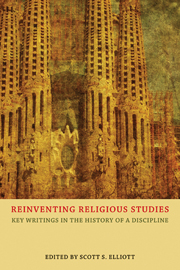Book contents
- Frontmatter
- Contents
- Introduction
- 1 For such a time as this: the Council of Societies for the Study of Religion, 1969–2009
- Part I Inventing and reinventing the field of religious studies
- Part II Method and theory in religious studies
- Part III Teaching religion
- Part IV Women and the bible in religious studies
- Part V Religion and religious studies in civic life
- Part VI Religious studies and identity politics
- 33 Late capitalism arrives on campus: making and remaking the study of religion
- 34 Religious studies and identity politics: mythology in the making
- 35 Toward an engaged religious studies
- 36 The study of religion under late capitalism, or commodity triumphant
- Part VII Islam and 9/11
- Bibliography
- Acknowledgments
- Index
35 - Toward an engaged religious studies
from Part VI - Religious studies and identity politics
- Frontmatter
- Contents
- Introduction
- 1 For such a time as this: the Council of Societies for the Study of Religion, 1969–2009
- Part I Inventing and reinventing the field of religious studies
- Part II Method and theory in religious studies
- Part III Teaching religion
- Part IV Women and the bible in religious studies
- Part V Religion and religious studies in civic life
- Part VI Religious studies and identity politics
- 33 Late capitalism arrives on campus: making and remaking the study of religion
- 34 Religious studies and identity politics: mythology in the making
- 35 Toward an engaged religious studies
- 36 The study of religion under late capitalism, or commodity triumphant
- Part VII Islam and 9/11
- Bibliography
- Acknowledgments
- Index
Summary
Right now, anthropologist Steve Lansing is studying the regulation of rice-paddy irrigation on the island of Bali. As a result of the Green Revolution, Balinese rice-farmers have gotten into real ecological trouble. Lansing went to Bali and conducted an in-depth analysis of traditional irrigation methods. He has discovered that traditional water-sharing strategies optimize the rice production by coordinating the cropping patterns of farmers over a fairly large area. This coordination is implemented through the religious system of the Balinese, and a more complete understanding of how the religious system functions should provide important clues as to how new technologies could be smoothly incorporated into contemporary institutional structures. Lansing himself is working with Apple Computers to provide a computer simulation of the entire system to the local water-temple priests to aid them in their planning.
In Central America, anthropologist Scott Atran and psychologist Doug Medin are studying sustainable forest management among the Itza Maya. Atran and Medin are particularly interested in what statements like “At night you can hear the forest breathing” and “The forest spirits are not seen as often as they used to be” indicate about the way the Itza think about the forest. At a minimum, these statements would seem to indicate that the Itza do not employ a cost-benefit analysis when thinking about the forest, i.e., in some sense the forest is sacred. Itza behavior seems to bear this out also. One of the most important questions Atran and Medin are confronting is “How does ‘sanctity’ function to maintain a sustainable ecosystem?”
- Type
- Chapter
- Information
- Reinventing Religious StudiesKey Writings in the History of a Discipline, pp. 218 - 220Publisher: Acumen PublishingPrint publication year: 2013



